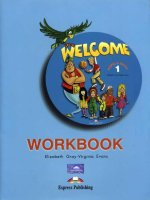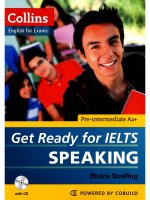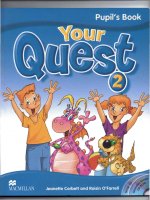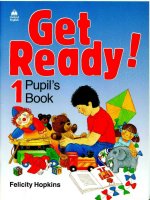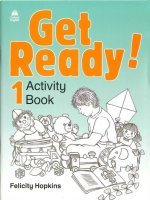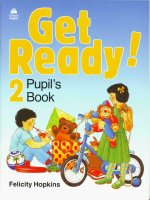get ready 1 pupils book
Bạn đang xem bản rút gọn của tài liệu. Xem và tải ngay bản đầy đủ của tài liệu tại đây (20.05 MB, 64 trang )
Pupil's
Book
Felicity Hopkins
Note
Most of the activities in this book are oral. The words printed
in black are there to guide the teacher. Only the words
or letters printed in a colour are for the pupil to read or
recognize.
Oxford University Press
Notes for the teacher
Get Ready! aims to give pupils a feel for
English and to establish a sound basis for
later learning. Pupil's Book 1 can be
used alone or in conjunction with the
Activity Book, Handwriting Book and
Numbers Book. A cassette has recordings
of all the dialogues and songs in the Pupil's
Book. Where an item has been recorded a
cassette symbol (EH) appears in the Pupil's
Book.
Oral work
Most of the work based on Pupil's Book 1
is oral. Only the words or letters printed in a
colour are for the pupil to read. The words
in black are there to guide the teacher.
The pictures are to help the pupil, and the
teacher should encourage the pupils to
point to the pictures when reciting rhymes
or singing songs. The expressions shown in
the Language Summary do not all appear in
the text of the Pupil's Book, but they should
be used orally by the teacher. The Picture
Practice pages are designed to practise
vocabulary and these expressions. The
Teacher's Book provides detailed notes on
when to introduce them.
Reading
There is no 'real' reading in Get Ready! 1
but pupils will learn to recognize the letters
of the alphabet and know the sound each
one makes. They will also learn some
whole words and acquire left-right
orientation. These first reading skills are
developed in both the Pupil's Book and the
Activity Book.
The alphabet
It is suggested that the sounds of the letters
should be taught first of all, using the
formula 'a' for apple, 'b' for boy, etc. The
names of the letters can be taught later,
through exercises in the Activity Book.
The approach
The teacher should use choral and
individual repetition and question and
answer routines. Whenever possible, pupils
should take on the role of the teacher and
ask the questions. Games, such as the one
in Step 14, are particularly suitable for this.
The songs are a very important element
of Get Ready! and teachers should
regularly use songs from earlier in the
course. While singing, pupils should point
to the pictures or perform the suggested
actions. These reinforce meaning as well
as make learning more enjoyable. Do not
expect pupils to understand every word in
the songs.
Accuracy
Do not be too concerned about accuracy.
Get Ready! progresses slowly and pupils
will gradually become aware of small
differences and more able to imitate the
teacher's model. Never try to explain
language rules to very young learners.
Mother tongue
Most of the lesson should be in English but
do use the pupils' own language when it
would be helpful. You might use it, for
example, when explaining a game or the
meaning of a song.
Language summary
Vocabulary*
Functional areas
Expressions*
Steps
1-15
Identification
Quantity
Look/Look at
I am, it is
Steps
16-30
Description
What colour is ... ?
What is this word/
letter/number?
Point to . . .
Small letters t-z
Nouns beginning
with t-z
Classroom objects
Colours
big/little
Steps
31-45
Possession
/ have, Sue has
How old are you?
Toys
my
Steps
46-60
Revision of Steps
1-45
Revision of Steps
1-45
Numbers 7-70
Parts of the body
Shapes
What is this?
Is it a ... ? Yes/No
How many?
Small letters a-s
Numbers 1-6
Nouns beginning
with a-s
*At the back of this book there is a complete list of the words used in the text of the Pupil's Book.
The Teacher's Book gives full guidance on the language syllabus and its presentation to the pupils.
OXFORD
UNIVERSITY PRESS
Great Clarendon Street, Oxford 0x2 6DP
Oxford University Press is a department of the University of Oxford.
OXFORD and OXFORD ENGLISH are registered trade marks of
Oxford University Press in the UK and in certain other countries
ISBN-13: 978 0 19 433912 4
ISBN-10: 0-19-433912-2
© Oxford University Press 1999
The moral rights of the author have been asserted
Database right Oxford University Press (maker)
First published 1988
2008 2007 2006 2005
Printed in China
ACKNOWLEDGEMENT
Illustrated by: Ray and Corinne Burrows
STEP I
Look and say
Jack
Sue
Song
Hello song
Hello, hello, hello.
Hello, hello, hello.
Hello, hello, hello.
I am Sue.
Hello, hello, hello.
Hello, hello, hello.
Hello, hello, hello.
I am Jack.
STEP 2
Letters
apple
bird
Song
Goodbye Jack and Sue.
Goodbye Jack.
Goodbye Sue.
Goodbye Jack and Sue.
Goodbye Jack and Sue.
Goodbye song
STEP 3
Letters
cat
dog
Numbers
STEP 4
Rhyme
One bird
Two birds
Three birds
CAT!
One cat
Two cats
Three cats
DOG!
STEP 5
Letters
elephant
fish
girl
STEP 6
Rhyme
One
boy.
Two
boys.
Three
boys.
JACK!
Game
How many
fingers?
One
girl.
Two
girls.
Three
girls.
SUE!
STEP 7
Letters
hand
insect
jug
STEP 8
Song
Elephants and fishes
How many elephants?
Elephants, elephants.
How many elephants?
One, two, three.
How many fishes?
Fishes, fishes.
How many fishes?
One, two, three.
Hello elephants!
Hello fishes!
Elephants and fishes.
One, two, three.
STEP
Numbers
Song
Listen to the numbers
One, two, three,
Clap, clap, clap.
(x3)
Listen to the numbers.
Four, five, six.
Tap, tap, tap.
(x3)
Listen to the numbers.
One, two, three,
Four, five, six.
Clap, clap, clap.
Tap, tap, tap.
One, two, three,
Four, five six.
Listen to the numbers.
STEP 10
Picture practice
Show me a bird.
How many cats?
STEP 1 1
Letters
kite
lion
monkey
STEP 13
Letters
nest
orange
pencil
STEP 14
Game
Look at number 4.
Is it a monkey? No!
Is it a girl? No!
Is it a boy? Yes!
finger/insect/pencil
cat/dog/lion
bird/insect/kite
monkey/girl/boy
fish/insect/elephant
orange/jug/apple
STEP 15
Letters
queen
robot
sun
STEP 16
Game
What is it?
A big pencil
A little pencil
Hands down!
Hands up!
Clap, clap, clap.
Show me.
Is it big?
Is it little?
What is it?
A little pencil.
STEP 17
Look and say
Point to a ...
STEP 18
Picture practice
Look at robot number two.
Is it a big robot?
Song
Sue is a little girl.
Look at Sue.
Jack is a little boy.
Look at Jack.
Little girl, little girl,
Look at Sue.
Little boy, little boy,
Look at Jack.
Little girl, little boy
STEP
Letters
tree
umbrella
van
STEP 20
Look and say
a red umbrella
Song
a green umbrella
Sue's umbrella
Show me blue and show me red.
Look at a blue sky,
And look at Sue's umbrella.
Show me green and show me red.
Look at a green tree,
And look at Sue's umbrella.
Sun up, sun down, show me red.
Look at a red sky,
And look at Sue's umbrella.
a blue umbrella
STEP 21
Letters
window
x-ray
yellow
zoo
STEP 22
Picture practice
Show me a big monkey.
Is it blue?
Show me a green van.




